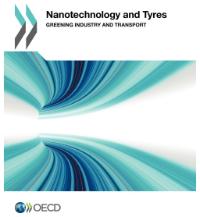Jul 29 2014
The use of new nanomaterials in tyre production could help foster the sustainability of the tyre industry and reduce the environmental impact of vehicles, if the potential environmental, health and safety risks of the technology are managed carefully, according to the new OECD report Nanotechnology and Tyres: Greening Industry and Transport.
 report cover. Image Credit: OECD.
report cover. Image Credit: OECD.
The report presents the potential of new nanomaterials and highlights the remaining challenges for their safe and sustainable introduction in the tyre industry.
New nanomaterials offer promising avenues for future innovation, which can contribute towards the sustainability and resource efficiency of the tyre industry and of the transport sector. For example, new nanomaterials have the potential to decrease tyre rolling resistance (improving vehicle’s fuel consumption and CO2 emissions) and improve wear resistance (increasing tyre lifetime) while maintaining wet grip and existing safety levels.
Yet tools and frameworks are needed to support decision making for assessing the economic, social and environmental impacts of the introduction of new nanomaterials in tyre production. In particular the development of industry-specific guidance to assess the environmental, health and safety risks at various stages of products development is critical.
The OECD report provides a risk management framework to enable site-specific or company-specific risk assessments or risk management strategies for using nanomaterials as additives in tyres. It also gives an insights into: the status of nanotechnology innovation in the sector and the drivers of innovation in the tyre industry; the economic and social costs and benefits of using nanotechnology in tyres; the safe use of new nanomaterials at all stages of their life cycles; the identification of the tools and frameworks supporting decision making at various stages of product development; and the facilitation of outreach and knowledge transfer on the safe use of new nanomaterials.
The report emphasises the importance of:
- The policies to support research in the environmental, health and safety risks, as well as those to support the commercialisation of nanotechnology research results, for fostering responsible innovation in the tyre sector;
- available tools (e.g. cost/benefit analysis, LCA) to gain better insight into the socio-economic and environmental impacts of nanotechnology applications;
- Collaboration between governments and industry to address the specific challenges raised by the introduction of new nanomaterials in different industry sectors.
This report summarises the conclusions of a two years project, which was originally proposed and supported by the Business and Industry Advisor Committee to the OECD (BIAC) through the Tyre Industry Project (TIP) of the World Business Council for Sustainable Development (WBCSD).
Source: OECD /...